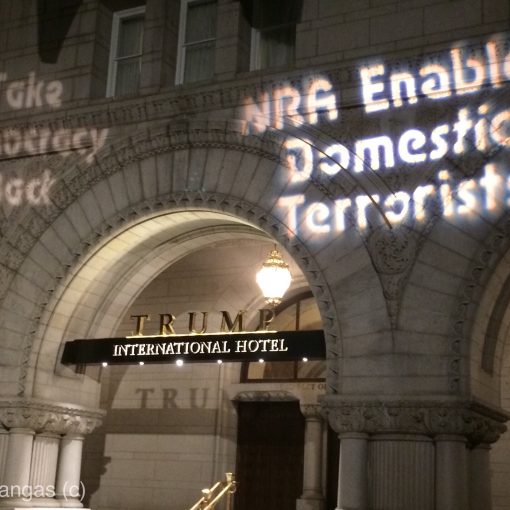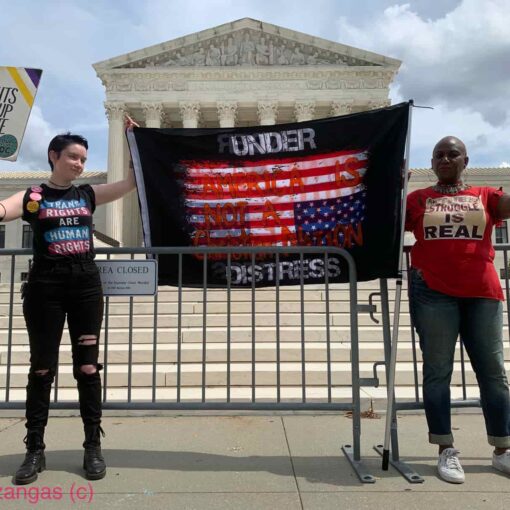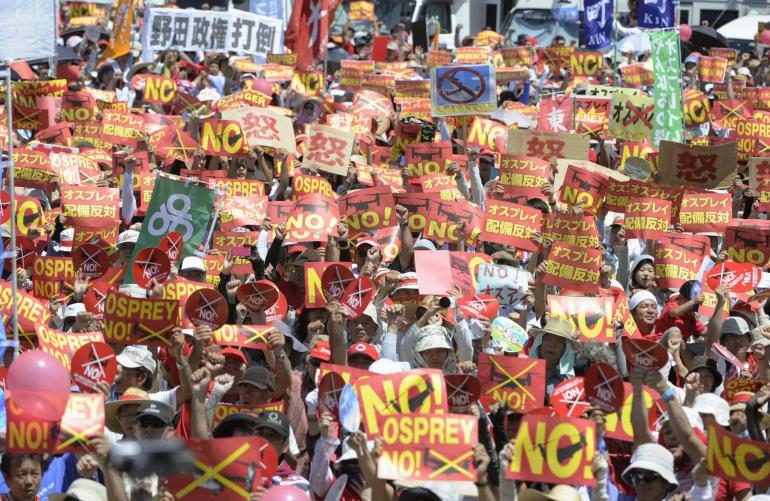
Mayor Susumu Inamine of Nago City, Okinawa, an Island south of Japan, made a direct appeal to the US government to back off on plans to build a military air base at Henoko on the island coast, saying Okinawans had been “enduring a heavy burden.” He visited New York and Washington, DC from May 16 to 23 to convey the broad-based opposition of Nago City residents and Okinawans at large to the relocation of Marine Corps air base Futenma.
“There is no way we can say yes to this relocation plan,” said Mayor Inamine.
What is being called a relocation is actually construction of a whole new airfield. The US and Tokyo negotiated new military air base construction at Henoko in exchange for closure of Futenma, a Marine air base within the Ginowan city limits of Okinawa. Urban growth put civilians in closer proximity to the base, posing danger to them and subjecting them to noisy aricraft. The plan to build the new base at Henoko was approved by Okinawa Governor Hirokazu Nakaima in December 2013.
“Since the end of World War II, Okinawa people have been enduring this heavy burden of holding 74% of the entire US bases in Japan,” said Mayor Inamine. The Mayor made appearances at Columbia University in New York and the Cato Institute and the National Press Building in Washington, DC.
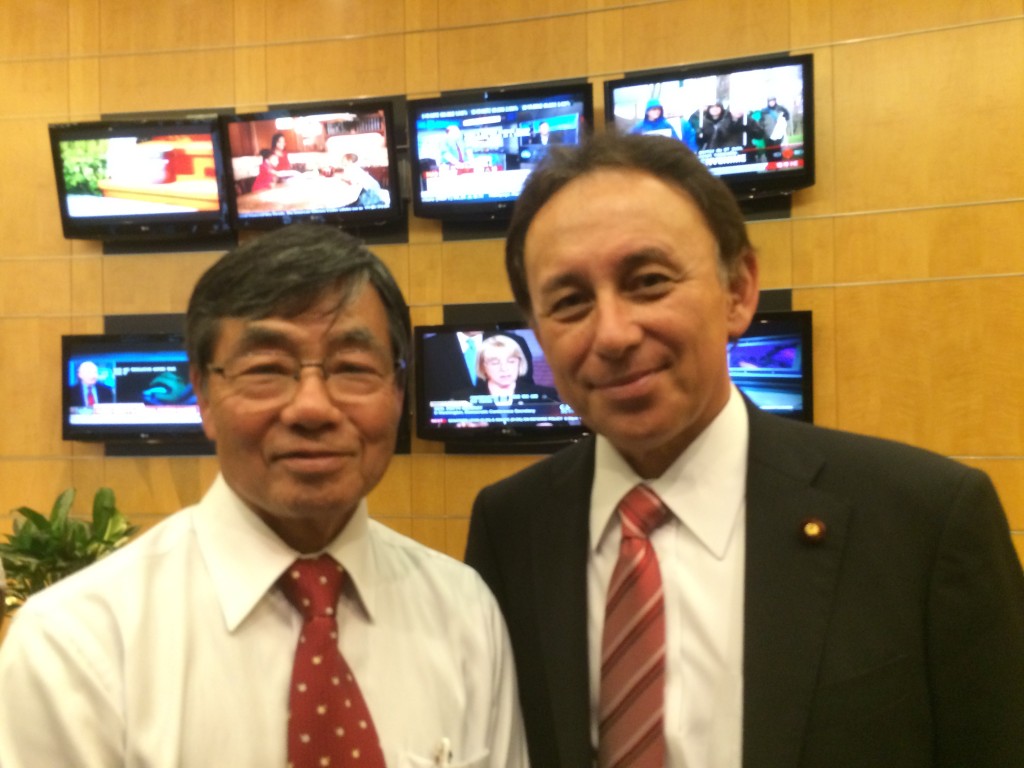
With rising Pacific tensions, Okinawa is caught in a three-way vice: occupation by US forces, a growing assertive Chinese military and its citizens’ desire for autonomy. Moreover, the disputed Senkaku Islands, part of the Okinawa prefecture, are caught in a tug of war for control between China and Japan.
Mayor Inamine expressed concerns with continuing US military occupation of the Island. The US military has maintained an occupying presence in Okinawa since WWII when the battle for Okinawa claimed the lives of 25% of the Island. In 1972, the US ceded control of Okinawa to Japanese sovereignty but continued to maintain thirty-two military bases and about 26,000 military personnel there. While the US paid for base construction and operation, Japan provided the territory under a treaty signed in 1951 and re-signed in 1960. With two US air bases–US Air Force Kadina and US Marine Corps Futenma–in operation on the island, construction at Henoko fans a smoldering flame regarding rights of Okinawans to reclaim land taken after a war which ended 70 years ago.
Kadina Air Base has two strategic bomber runways capable of handling B-52 bombers, cargo aircraft, commercial Military Airlift Command flights and other long-range aircraft. Camp Futenma, on the other hand, is smaller with dual runways capable of handling helicopters and Osprey jet fighters. The plan to close Futenma has been at an impasse for 17 years as negotiations bogged down over ecological concerns. But with recent approval of sea landfill at Henoko, Okinawans plan to challenge the permit to build.
Mayor Inamine, who was reelected on a platform to stop Henoko air base construction, remains committed to reducing the US military footprint on Okinawa. The US may have underestimated his resolve. “I as mayor have operational control over two ports that are needed for use as construction landfill, and I will exercise all my powers in the municipality to block access,” he said to RT.
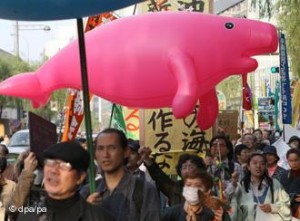 The placement of the new base at Henoko could negatively affect the Dugong, a species of manatee, and other endangered aquatic life, including a rare sea turtle. Environmentalists are also worried about aircraft noise and pollution due to air base water runoff. “The sea in Henoko is a treasure trove for marine life, where the Okinawan Dugong and sea turtles live,” according to Close The Base, an environmental organization. Since 2004, Okinawans have staged annual sit-ins at Henoko Beach calling for protection of the aquatic life. Many Okinawans have protested this base since the 1980’s.
The placement of the new base at Henoko could negatively affect the Dugong, a species of manatee, and other endangered aquatic life, including a rare sea turtle. Environmentalists are also worried about aircraft noise and pollution due to air base water runoff. “The sea in Henoko is a treasure trove for marine life, where the Okinawan Dugong and sea turtles live,” according to Close The Base, an environmental organization. Since 2004, Okinawans have staged annual sit-ins at Henoko Beach calling for protection of the aquatic life. Many Okinawans have protested this base since the 1980’s.
Relations between Okinawans and the US military have periodically flared up over serious capital crimes committed by military personnel. Student and labor group protests forced closure of bases after incidents of criminal activity by US service men. In 1984, several US Marines robbed and murdered a taxi driver. In 1995, three military personnel raped a young girl. This resulted in 24-hour, island-wide base closures. In 2002, 2008 and 2012, US service personnel were implicated in rapes.
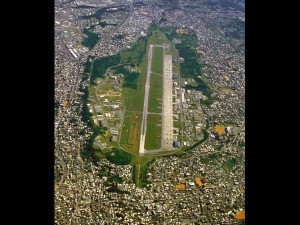
As the city of Ginowa expanded, the urban population encroached on air base property. There was growing concern with noise and possible aircraft accidents. This led to more support for Futenma base closure. In 2012, tens of thousands of Okinawans protested deployment of the Osprey tilt rotor aircraft at Futenma air base.
Okinawa is also at odds with mainland Japan over continued US armed force occupation. Mainlanders regard the Island as a tropical paradise. Island government autonomy has led to tension with the Mainland. Okinawa was not always a part of Japan; Japan annexed the Kingdom of Ryukyu and the Okinawa Islands in 1879.
Congressman Denny Tamaki, a member of the House of Representatives in Tokyo, traveled with Mayor Inamine’s delegation to help lobby for a moratorium to build at Henoko. “Once this new base is built, it is going to last 100 years,” he said. Another base is “too heavy a burden to ask of this tiny prefecture,” he said. The new agreement to build at Henoko gives the US a hundred-year lease at the site.
Japan mainland is 378,000 sq km, while Okinawa is a comparatively small 1,200 sq km, less than 1% of Japan’s land mass. While mainland Japan hosts US bases on less than .01% of its terrain, 18% of Okinawa is occupied by US based forces. Mayor Inamine believes Okinawans bear the brunt of the burden. Nearly 75% of them oppose the new air base.
The US intends to increase global Pacific readiness in response to Chinese and North Korea military expansion. Recent Naval skirmishes between China, Vietnam, the Philippines, as well as nuclear and missile tests in North Korea, are fanning US militarily expansion throughout the Pacific.
In spite of overwhelming powers at play in the new battle for Okinawa, Mayor Inamine is not likely to back down from his quest to stop Henoko air base. “This is not a future we want for Okinawa or a future for generations to come,” he said.




